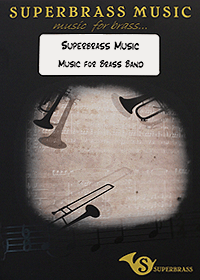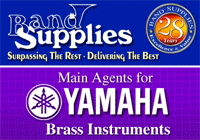The Regimental Band of Her Majesty’s Coldstream Guards
15-Sep-2005British Wind Band Music,
Conductor: Major G.O. Jones
St John’s, Smith Square,
London,
Tuesday 13th September
The beautiful setting of St John's, Smith Square, home of Enfield Citadel Band's pre-contest festivals for a number of years now, was arrayed in different shades of scarlet and blue as the Coldstream Guards band, under their Director of Music Major Graham Jones, took the stage for an evening of series British works for wind band. Sandwiched between ceremonial duties at Buckingham Palace, it was a world away from the typical fare of the bandstand, and attracted a respectable crowd for what proved to be quite a feat of endurance and stamina.
The first part of the programme consisted of two works by Gordon Jacob, master orchestrator and well-respected teacher, and whose works for brass and wind band do not always receive due recognition. Members of the Jacob family were present and received a warm reception from the audience. The "Concerto for Band" is a three movement work that, as its title would imply, provides the opportunity for each section of the band to show what it's made of, all the more so when, as on this occasion, there is no unnecessary doubling of parts. It was encouraging to see such instruments as Eb, alto and bass clarinets covering the appropriate parts.
From the opening "Allegro", one was struck by the fullness of the sound, with sustained brass and flowing woodwinds, with the acoustic of the church proving ideal. Jaunty, even spiky, rhythms contrasted with chorale-like passages, and various duets were heard oboe/flute, alto sax/cornet whilst the four-man percussion section were also kept gainfully employed. Intonation was very good from the start, with none of the squeakiness that can sometimes be associated with wind ensembles, and the horn section (not for the first time) was very impressive.
The "Adagio" brought a complete change, calling for playing of great delicacy, with first a cornet duet backed by the trombones, followed by clarinets supported by the horns. The dove-tailing of melody lines was particularly impressive, and all the parts blended well together. There was also the first opportunity to hear some fine euphonium playing, somewhat reminiscent of the same composer's "Fantasia" for euphonium and band, which made one regret that the euphonium does not play a more prominent role in many wind arrangements.
Finally, the "Allegro con brio" sprang into life, with angular phrases in canon moving around the band. The bass clarinet came into prominence and there was some fine tuba playing, particularly at the bottom of the section. The interweaving of parts gave ample opportunity for display, and demonstrated how adept Gordon Jacob was as an orchestrator. Following a slower section from the brass, the intensity increased into the final "fugato" section as the concerto reached a rousing climax.
"Music for a Festival" was commissioned for the Festival of Britain in 1951, and was designed to be played by massed forces, but it is playable, as on this occasion, by a 7 piece brass group (four trumpets and three trombones) and a standard-sized band. Consisting of eleven movements, the odd numbered sections feature the brass, with occasional percussion, and the even numbers are for the band. It is a piece of contrasts, and is in its own way very demanding, particularly for the brass group, which probably accounts in part for the lack of performances. For this performance, the brass playing conventional trumpets and trombones rather than fanfare trumpets were located on risers behind the main band but in front of the percussion, and with the players in the band using cornets the tonal contrast was maintained.
From the opening "Intrada" it was clear there was to be nowhere for the brass players to hide not that they needed to! The second movement, "Overture" saw unison phrases played across the band, with a driving bass part and a telling contribution from the piccolo. Back to the brass for the "Round of seven parts" which "did exactly what it said on the can", calling for some clean articulation from the trombones as they followed the trumpets' lead.
The "Air" presented a cornet solo over a passacaglia from the band, with constantly flowing quavers underlying the continual movement. An "Interlude" from the brass led suddenly into a "March" that had more than a touch of Vaughan Williams' "Sea Songs" about it, with a very attractive trio melody played by saxes, euphonium and bassoon in unison. The "Saraband" brought some particularly well-controlled playing from the brass group, with the sensitive timpani player serving to enhance the overall effect. At times it was hard to believe that only seven instruments were playing, and the tone colours were very varied.
The "Scherzo" opened with lively figures from the upper woodwind, and is possibly the most familiar movement of the piece. Sweeping arpeggios and runs could have been extracted from orchestrations of Bach toccatas, and there was more fine tuba pedal work no coarseness, but immense power and depth of sound. During the ensuing "Madrigal" it was possible to imagine a group of singers gathered round four sides of a table as they read off the part-books, and it ended with a striking contribution from the bass trombone. The "Minuet and trio" featured a melody on the oboe and alto sax, with effective rises and falls in the accompaniment.
The "Finale (Fanfare & Fugue)" united the two groups, with the brass playing the opening fanfare. The fugue, when it started, had an almost jazzy feel with its syncopated rhythm, reminding this listener somewhat of Alec Templeton's "Bach goes to town". An effective feature came when the lower half of the band played the tune in augmentation while the main fugue continued in the upper half. Following enthusiastic applause, particularly for the brass ensemble, the band departed for some well-earned refreshments.
Malcolm Arnold's "H.R.H. Duke of Cambridge March" was chosen to open the second half possibly not quite Arnold at his best, but with more than enough characteristic touches to justify its inclusion. It was taken at a cracking pace, with very smooth playing from the horn triplets against the 4/4 of the rest of the band, although the trumpets now playing across the band seemed rather overwhelmed on occasion.
The remainder of the evening consisted of two works by Martin Ellerby, who was introduced to the audience by Major Jones, explaining that he had just taken over from Peter Graham as the band's Composer in Residence, a position he also currently holds with the YBS band. He pointed out a link between the two main featured composers, in that Gordon Jacob had taught Joseph Horovitz, who in turn had been one of Martin Ellerby's tutors. The Major also took the opportunity to thank the Colonel of the Regiment, who was present for the concert, for the support given to the band, and in particular for the funds provided to commission new music.
"Paris Sketches" (written in 1994 but revised in 2004) was the first work Martin Ellerby composed for wind, and is a tribute to Paris itself, and those who live and work there, making particular use of various bells which can be heard in that city:
"Saint-Germain-des-Pres - the Latin Quarter" is famous for its artists and students. It came across as hauntingly atmospheric, with the horns dominating the texture and shades of Ravel in the impressionistic nature of the music.
"Pigalle: the Soho of Paris" was presented as a burlesque, with angular phrases being passed round the band and the imitation of car horns and sirens. Some effective flutter-tonguing from the brass added a little bite and the percussion were given full rein.
"Pere Lachaise", representing the city's largest cemetery, is the slow movement, with a steady ¾ pulse, soft and delicate playing and more than a nod towards Erik Satie's "Gymnopedies". Here there was a moment's uncertainty of intonation as the saxophone soloist tackled the awkwardly low lying melody, but it detracted little from the overall effect.
"Les Halles" provided a bustling finale, as befits a market area, opening with a striking flourish from the horns that was then taken up across the band, and full of cross-rhythms as 3s were effectively set against 4s. There are references to Berlioz's "Te Deum", premiered in a church in "Les Halles" in 1855, and following a massive crescendo, led by the percussion, the movement ended with the closing bars of the Berlioz work.
The final item in the programme, "The Cries of London" was the World Premiere of a new work commissioned by and dedicated to the band and their Director of Music. The composer explained how he had visited the band as part of his preparation, writing it with specific players in mind, and incorporating the bugle call of the 2nd Battalion into the opening movement, "Dawn Watch".
The movement started atmospherically, leading into the call, presented by four trumpeters, on this occasion placed one either side on the stage and one in either balcony. Particular mention should be made of the inconspicuous manner in which the trumpeters moved to and from their respective positions. Under the trumpet calls, the brass played a chorale that led without a break into the 2nd movement, "Westminster Chimes". As one might expect, the famous tones were heard, but transformed and developed extensively before the movement was brought to a rather unexpected close.
"A dream or two" featured the band's vocalist, James Scott, and also had prominent parts for harp and piano. The words of the popular song "London Bridge is Falling Down" formed the basis of the movement, with the "fair lady" referring to the city of London itself, and much use of minor chords to produce a feeling of melancholy. Rippling clarinet figures gave the impression of the water flowing, assisted by the harp, played by one of two guest musicians (the other assisting on oboe). The words were given in the programme, but were perfectly clear, the scoring allowing the vocal line to emerge from the texture with no difficulty.
The scherzo, "Catch that catch can", based on a series of rounds originating from the 17th & 18th centuries, included a jazzy contribution from the string bass (used throughout the second half of the programme). Various duets and ensembles were featured, and even the percussion joined in with a round by Purcell! The tunes came thick and fast, including a round for euphonium and tubas, with the "Westminster Chimes" appearing, not to mention the unexpected appearance of "Pop goes the weasel".
With "Evening Watch" the opening movement was reworked in minor mode, with the trumpet calls taking on even more of a haunting quality, leading without a break into the finale, "Hymn". This was based on the "National Anthem", although it took a while for the melody itself to be heard. At times reminiscent of Beethoven's "Wellington's Victory" and just stopping short of Charles Ives, this nevertheless formed a fitting and majestic conclusion to the piece, and seemed quite apt for a celebration of the city of London.
It was certainly well received by the audience, who had enjoyed an evening of first-rate music-making from the gentlemen (and lady) of the band. All those involved are to be commended, and it is to be hoped that this may be the first of a series of concerts devoted to serious music for wind. The band is clearly in good form, with talented players throughout, and should be well received on their forth-coming trip to Japan, where they will feature on their programmes Rodney Newton's new commission "Constellations".
Peter Bale









